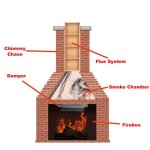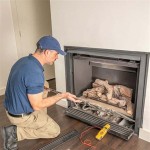Painting A Fireplace: From Drab to Dramatic
Painting a fireplace is a relatively straightforward do-it-yourself project that can dramatically transform the appearance of a living space. Many fireplaces, particularly older models constructed of brick, stone, or outdated tile, can appear drab or clash with a home's current aesthetic. A fresh coat of paint can revitalize the fireplace, making it a focal point that complements the overall design.
This article will detail the process of painting a fireplace, from preparation to completion, focusing on crucial steps and considerations to achieve a professional-looking finish. It will also explore the different paint types suitable for fireplaces and provide before-and-after examples to illustrate the transformative power of paint.
Key Considerations Before Painting
Before embarking on the project, several factors must be assessed. First and foremost, the material of the fireplace surround needs to be identified. Brick, stone, concrete, and tile each have different porosities and textures, affecting paint adhesion and requiring specific preparation techniques. Once the material is identified, one must consider the type of fire used in the fireplace. Gas fireplaces produce less soot and heat than wood-burning fireplaces, influencing the choice of paint.
Next, the desired aesthetic needs to be determined. A modern, minimalist look might call for a solid, matte color, while a more rustic aesthetic could involve distressing techniques or using a textured paint. Finally, one must consider the functionality of the fireplace. Is it primarily decorative, or is it used frequently? High heat exposure necessitates heat-resistant paint, especially around the firebox.
Preparation: The Foundation for a Flawless Finish
Proper preparation is critical for a successful paint job. Neglecting this step can lead to peeling, chipping, and an overall uneven appearance. The first step is thorough cleaning. Use a wire brush to remove loose mortar, soot, and debris. A specialized fireplace cleaner or a solution of trisodium phosphate (TSP) mixed with water can be used to degrease the surface, removing accumulated grime and soot. Follow the manufacturer’s instructions when using TSP, as it can be harsh and requires protective gear.
After cleaning, rinse the fireplace thoroughly with clean water and allow it to dry completely. This may take several hours, or even overnight, depending on the material and the humidity level. Once dry, inspect the surface for cracks or imperfections. Fill any cracks or holes with a masonry patching compound or caulk suitable for high-temperature applications. Allow the patching compound to dry and cure according to the manufacturer's instructions, then sand it smooth to blend with the surrounding surface. Protect the surrounding area with painter's tape and drop cloths to prevent unwanted paint splatters.
Priming is an essential step, particularly for porous materials like brick and stone. A masonry primer creates a uniform surface for the paint to adhere to, improving its durability and longevity. Choose a primer specifically designed for masonry or high-temperature applications. Apply the primer evenly with a brush or roller, ensuring to cover all surfaces, including grout lines and crevices. Allow the primer to dry completely before proceeding to the painting stage.
Selecting the Right Paint
Choosing the appropriate paint is paramount for a fireplace, considering its exposure to heat and potential for soot. Latex paint is a common choice for interior surfaces, but it may not withstand the high temperatures generated by a working fireplace. Oil-based paints offer better heat resistance, but they are more prone to yellowing over time and require mineral spirits for cleanup. Specialized high-temperature paints, often used for stoves and grills, provide the best heat resistance and durability but may have limited color options.
For gas fireplaces used infrequently, a high-quality acrylic latex paint formulated for interior use may suffice. However, for wood-burning fireplaces or those used frequently, a high-temperature paint specifically designed for fireplaces and stoves is recommended. These paints are formulated to withstand temperatures up to 1200°F (649°C) and are resistant to chipping, cracking, and fading.
When selecting the color, consider the overall aesthetic of the room. Neutral colors such as white, gray, and beige are versatile and blend well with various décor styles. Darker colors like black or charcoal can create a dramatic focal point. Sample paint colors on a small, inconspicuous area of the fireplace before committing to the entire project to ensure the color complements the surrounding space.
The Painting Process
Once the fireplace is prepped and the paint is selected, the painting process can begin. Start by applying the paint to the edges and corners using a brush. This technique, known as "cutting in," creates clean lines and ensures thorough coverage in hard-to-reach areas. Use a high-quality brush with synthetic bristles for latex paints and natural bristles for oil-based paints.
Next, use a roller to apply the paint to the larger, flat surfaces. Choose a roller with a nap appropriate for the texture of the fireplace material. A short nap roller is suitable for smooth surfaces like tile, while a longer nap roller is better for textured surfaces like brick and stone. Apply the paint in thin, even coats, working in small sections to avoid drips and runs. Overlapping each stroke slightly ensures uniform coverage.
Allow the first coat of paint to dry completely before applying the second coat. This is crucial for achieving a smooth, even finish. The drying time will vary depending on the type of paint and the ambient temperature and humidity. Refer to the manufacturer's instructions for specific drying times. Apply a second coat of paint in the same manner as the first, ensuring thorough coverage. For porous surfaces like brick and stone, a third coat may be necessary to achieve full opacity.
After the final coat of paint has dried completely, carefully remove the painter's tape. Use a utility knife to score along the edge of the tape before peeling it off to prevent the paint from chipping. Inspect the painted surface for any imperfections, such as drips, runs, or missed spots. Touch up any imperfections with a small brush. Allow the touched-up areas to dry completely before using the fireplace.
Before and After Examples
The impact of painting a fireplace can be substantial. Consider a fireplace constructed of dark, reddish-brown brick that clashes with a newly renovated living room featuring light gray walls and modern furniture. Before painting, the fireplace appears dated and out of place. After painting the brick a crisp, clean white, the fireplace seamlessly integrates with the room's aesthetic, becoming a sophisticated focal point.
Another example involves a fireplace with dated, glossy ceramic tiles. Before painting, the tiles appear worn and detract from the room's overall appearance. After painting the tiles with a matte gray paint specifically designed for tile surfaces, the fireplace takes on a modern, updated look. The matte finish creates a softer, more inviting atmosphere.
A further example involves a dull, gray concrete fireplace surround. Before painting, the concrete appears unremarkable and lacks character. After painting the concrete a deep charcoal color and applying a dry-brush technique with a lighter gray paint, the fireplace gains depth and texture. The dry-brush technique creates a subtle, weathered look that adds visual interest to the room.
Maintaining a Painted Fireplace
Proper maintenance is crucial for preserving the appearance of a painted fireplace. Regularly dust the surface with a soft cloth to remove accumulated dust and soot. Clean any spills or splatters immediately with a damp cloth. Avoid using harsh chemicals or abrasive cleaners, as they can damage the paint finish.
For fireplaces used frequently, inspect the painted surface periodically for signs of chipping or cracking. Touch up any damaged areas with a small brush and the original paint color. Consider applying a protective sealant to the painted surface to enhance its durability and resistance to staining. A matte sealant will help maintain the paint's original finish, while a gloss sealant will add a subtle sheen.

Before After Brick Anew Fireplace Paint

Painting Brick Fireplace White A Renovation Story

How To Paint Your Brick Fireplace Katie Lamb

How To Make Over A Brick Fireplace Quickly Easily And Ly Pinkscharming

Fireplace Remodel Home Remodeling Brick Makeover
Making Progress Painted Fireplace Complete 619 Miles

How To Paint Your Fireplace Brick Surround

Fireplace Decorating My Brick Painted Is Stunning Paint Makeover Red Fireplaces

Paint Fireplace Brick

Brick Anew Fireplace Painting The Stunning Natural Look
Related Posts








